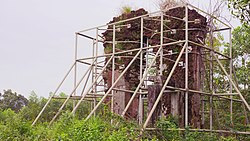Indrapura (Champa)
| Indrapura | |
|---|---|
| ឦន្ទ្រពុរ | |
 The ruins of Đồng Dương Monastery | |
| Type | Former capital of Champa |
| Location | Quảng Nam province, Central Vietnam |
| Coordinates | 15°40′01″N 108°22′59″E / 15.66694°N 108.38306°E |
| Founded | 875 |
| Founder | Indravarman II |
| Demolished | 1471, 1969 |
Indrapura was the capital city of the kingdom of
Nomenclature
The name "Indrapura" (the modern toponym is "Đồng Dương") was translated in Chinese and Vietnamese sources as Fóshì/Phật Thệ (Chinese: 佛逝) or Fóshìchéng (Chinese: 佛逝城, lit. 'the City of Indra' or 'the city of Buddha').[6] Previous generations of scholars had posited that "Fóshì" was a transcription of Vijaya (Chinese: 尸唎皮奈; pinyin: Shīlì Pínài; Vietnamese: Thị Lợi Bi Nai; alternate: Chà Bàn).[7]
History
Influence of Mahayana Buddhism
The city was built around 875 CE by
Buddhist temples extended as far north as Quảng Bình and across northern Champa. This led the 13th century Vietnamese king Trần Nhân Tông, a Buddhist devotee, to travel to Champa for nine months during which he visited Buddhist sacred sites.[10]
End and destruction

The rise of two neighboring powers,
In 983, a Vietnamese named
There was no proof that yāï po ku vijaya śrī Harivarman (r. 989–997), who was elected by the Cham to overthrow Lưu Kế Tông, had ever moved the capital south to Bình Ðịnh.[13] These historical accounts could be seen as evidence that a Vietnamese attack in 982 not on Indrapura, but on a city ruled by a minor king from the same Indrapura dynasty in modern-day Quảng Bình. Early scholarship misinterpretation had failed to recognize the fact that 'Foshi' in both Chinese and Vietnamese sources was indeed Indrapura, not Vijaya. Michael Vickery suggests it was likely an ostensibly endeavor of colonial-era scholars to link Chinese eponym Foshi with Southeast Asian Vijaya to solder the existence of the posited Srivijaya empire (rediscovered in 1911) which located in modern-day Indonesia.[14]
The possession of Champa power was then transferred to the hand to
Dong Duong and
Archaeology


Đồng Dương and surrounding sites during the height of the war were hotspots of the NLF (Vietcong) activities and bunkers. After the war as Champa sites throughout South Vietnam had received massive destructions, research on Champa resumed in the late 1980s and 1990s. In recent decades, Indrapura/Đồng Dương has been re-excavated, revealing new insights about the city during its magnificence.[17]
Modern-day vestiges of Indrapura/Đồng Dương are barely recognizable: eroded citadel; the royal palace area; watch towers; ruins of the Monastery; paved roads, bridges, and sewer system. It was a highly organized, well-urbanized city. Except for the remaining temples and shrines, most buildings in medieval Indrapura might have been constructed with wooden materials such as logs or bamboo.[17]
See also
- Tra Kieu
- Vijaya
Notes
- ISBN 978-0-8248-0368-1.
- ^ O'Reilly, 2006 p.139
- ISBN 978-9-747-53499-3.
- ^ Vickery, Michael Theodore (2005). Champa revised. University of London. p. 56.
- ISBN 978-9-747-53499-3.
- ^ Vickery, Michael Theodore (2005). Champa revised. Asia Research Institute, Singapore. p. 37.
- ^ Vickery, Michael Theodore (2005). Champa revised. Asia Research Institute, Singapore. pp. 42–44.
- ISBN 978-9-9716-9451-7.
- ISBN 978-9-9716-9451-7.
- ^ Vickery, Michael Theodore (2005). Champa revised. Asia Research Institute, Singapore. p. 76.
- ^ Vickery, Michael Theodore (2005). Champa revised. Asia Research Institute, Singapore. p. 45.
- History of Song, vol. 489
- ^ Vickery, Michael Theodore (2005). Champa revised. Asia Research Institute, Singapore. p. 48.
- ^ Vickery, Michael Theodore (2005). Champa revised. Asia Research Institute, Singapore. p. 46.
- ^ Ngo, Noseworthy & Quang 2021, p. 3.
- ^ Southworth, William Aelred (2001). The Origins of Campā in Central Vietnam: A Preliminary Review · Volume 1. University of London. p. 62.
- ^ .
References
- O'Reilly, Dougald J.W. (2006). Early Civilizations of south-east Asia. Altamira Press. ISBN 978-0-7591-0279-8.
- Ngô Văn Doanh (2006). Chămpa ancient towers: reality & legend. Hanoi: The Gioi Publishers.
- Finot, Louis (1904). "Notes d'épigraphie : VI. Inscriptions du Quang Nam" (PDF). BEFEO (in French). 4 (4): 83–115. ]
External links
- (in French) Historical photos of Champa archeological sites on EFEO website

